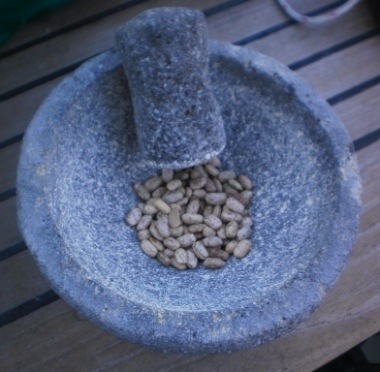Okay, let me just start by saying that, at the moment, I'm less than impressed with molcajetes. This may, and probably will change as I gain experience but right now....
But first, let's start with the seasoning process. As I said before, molcajetes are made from volcanic basalt. Beware of the cheap-o imitations made in whole or in part from concrete. These will never get properly seasoned. Seasoning basically consists of getting rid of all the grit that's going to slough off when you start grinding two volcanic rocks (the molcajete and the tejolote) together.
I checked Google to find out what the seasoning procedure was. I found a couple of youtube videos showing how to do it. Some folks opted for the industrialized easy way out and attacked the bowl with a very stiff wire brush on an electric grinder followed by a rinse with a high pressure washer. This would probably do the trick in a relatively short time. But these kitchen tools have been around for hundreds, maybe thousands of years and this approach just seems kind of, well, disrespectful. Other, more traditional methods were primarily geared around grinding uncooked rice to a fine powder as many times at it takes to have the rice powder not come out gray looking from the pumice dust. This could be just a couple times or as many as eight times, maybe more. After the dry rice procedure, rice mixed with a little water is ground up, forming a paste. When the paste stays white, you're ready to go.
I was just about to break out the rice when I found an even more traditional method. Lesley on The Mija Chronicles explains the right way to season a molcajete as well as the way she did it (aka: the wrong way). In this method, you start by grinding cracked corn to dust (4 times), then dried beans (4 times), then dry rice (4 times), and finally rice and a bit of water (3 times). This made sense to me . It's sort of like starting with 60 grit sandpaper and working your way down to 220 grit.
So, armed with my grains, my brush and my stone-age tools, I got to work.
First the corn:

After about 20 minutes I had a couple tablespoons of fine cornmeal.

Repeated this 3 more times and then, the beans:

The beans were harder. Probably because their round smooth shape made grinding them difficult. Once they broke open they were somewhat easier.

Again, I repeated this procedure 3 more times. Each time took about 20 minutes. Finally it was time for the grain that most instructions started with, the rice:

Repeated this 3 more times and then it was finally time for the rice/water slurry. For some reason, I didn't take pictures of this step but I'm sure by now you can imagine what it looked like. The final step in seasoning a molcajete is actually seasoning it. Everyone agrees that you grind up garlic and salt. After that, some recommend coriander, some oregano, some other stuff. I used what was on hand: garlic, salt and oregano. And, as long as I was grinding up the stuff anyway, might as well make some salsa, right?
I wasn't following any actual instructions for this. I just sort of had a vague idea that you put the vegetables in the molcajete and ground them all up together. So, I coarsely chunked up a couple of jalapeños, three tomatoes, an onion, and a handful of cilantro. To this I added some salt and started grinding.
Well, it didn't go quite as I hoped. Whenever we're in a restaurant down here (I almost said a Mexican restaurant), the salsa Mexicana that is served is obviously just cut up with a knife. Salsa Mexicana is what we commonly refer to in the US as Pico de Gallo. It's simply raw tomatoes, chiles, onions, garlic, and cilantro chopped up and mixed together. And it's chopped up with a knife, not a molcajete. I'm pretty sure I now know the reason for this. It's all about the skin.
In the few salsa-in-a-molcajete procedures I saw on youtube, they started with roasted vegetables. This is only partly to impart a char flavor. The bigger reason is that roasting the tomatoes and peppers under the broiler until they're blackened, and then letting them steam inside a bag for a few minutes, makes it really easy to peel the skins off. Why do we want the skins off? Because they're freakin' tough, that's why. I ground and I ground my raw vegetables in that molcajete and still the skins held together. Finally, on Lulu's suggestion, I dumped the whole mess in the string-pull food processor and chopped it up properly. But, hell, if I was going to use the food processor, why bother with the molcajete at all. No good reason, that's why.
So, my first molcajete experiment was a bust. Next time I'll roast and skin the vegetables like I'm supposed to. And maybe up the tomato to jalapeño ratio too. Either that or just make some quacamole. That shouldn't be too tough to grind up. I am happy to say that I haven't found any grit in the salsa yet.





2 comments:
You know what they say... If at first you don't succeed then maybe skydiving isn't for you.
No really... Too bad about the first run. Roasting and peeling sounds good though. I look forward to further info on this classic approach. What model string pull processor do you and Lulu use? We'll probably need one.
Tate
Tate,
This is our food processor:
http://www.williams-sonoma.com/products/veggiechop-vegetable-chopper/
and here's an old blog about it:
http://yodersafloat.blogspot.com/2010/05/592010-cool-kitchen-toy.html
Looks like I should have used TinyURL but I know you can handle it.
-Steve
Post a Comment